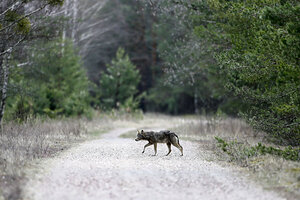Is wildlife thriving in Chernobyl's radioactive landscape?
Remote cameras in the Chernobyl Exclusion Zone found evidence of wildlife populations that appear to be unaffected by the nuclear contamination.

A wolf crosses a road near the abandoned village of Dronki, Belarus, in a forest in the exclusion zone around the Chernobyl nuclear reactor.
Vasily Fedosenko/Reuters
Thirty years after the worst nuclear accident in history, land once blanketed in radioactive fallout is now home to a stable wildlife population.
A new study on the Chernobyl Exclusion Zone (CEZ), the 1,000-square-mile area surrounding the Chernobyl Nuclear Power Station in Pripyat, Ukraine, found that animals are living normally in the exclusion area despite persistent radiation across the region.
The Chernobyl plant disaster of 1986 occurred when an explosion rocked the Soviet station and released large amounts of radiation across Europe, resulting in thousands of fatalities and widespread contamination. But after millions of dollars spent on recovery, and a total evacuation of humans, wildlife abounds in the protected landscape.
"Information regarding the response of flora and fauna to chronic radiation exposure is important in helping us understand the ecological consequences of past (e.g. Chernobyl and Fukushima) and potential future nuclear accidents," says an article in the current issue of Frontiers in Ecology and the Environment.
Reports of a "vibrant ecosystem in the most radioactive areas" in the CEZ have persisted for years, but the recent study more conclusively presents the scope of the animal presence in the zone and examines the effects severe radiation has on such populations.
"When humans are removed, nature flourishes – even in the wake of the world's worst nuclear accident," said Jim Smith, an environmental scientist at the University of Portsmouth in England, in an October interview with Reuters, following the release of another study pointing to the natural resurgence in the abandoned area.
"It's very likely that wildlife numbers at Chernobyl are now much higher than they were before the accident," he said.
The current research, performed by an international team of scientists, conducted a remote camera study in the Polesie State Radioecological Reserve, a portion of the CEZ located in Belarus. The scientists set up nearly 100 "scent stations" infused with fatty acid scents, designed to attract animals. Motion-activated infrared remote cameras recorded the activity of animals at the stations, which were distributed at least two miles apart to minimize the risk of the same animals visiting multiple sites during the survey.
The study was conducted over several weeks in 2014, during which various scent stations were activated for seven-day periods. The researchers found a total of 14 mammal species in the zone, including four – the Eurasian boar, gray wolf, raccoon dog, and red fox – seen often enough to qualify them as occupants of the region.
The results showed that, despite the lingering impact of the nuclear disaster, "Radiation did not negatively affect occupancy probability for any species," and that "the current distribution of wildlife within the CEZ is unaffected by [cesium-137] contaminant densities."
While the overall wildlife populations appeared strong, the team could not determine the lingering radiation's effects on individual animals. The scientists did suggest that "current levels of exposure are not limiting the distributions" of several of the surveyed species.
"We didn't find any evidence to support the idea that populations are suppressed in highly contaminated areas," said co-author James Beasley said in a University of Georgia press release. "What we did find was these animals were more likely to be found in areas of preferred habitat that have the things they need – food and water."
The new information presents a positive outlook for animals in the CEZ, but the researchers wrote that further investigation would be needed to conclusively determine how radiation impacts other aspects of individual animals and populations as a whole.
As previous researchers wrote, after discovering the ecological richness of the CEZ, "Radioactivity at the level associated with the Chernobyl meltdown does have discernible, negative impacts on plant and animal life. However, the benefit of excluding humans from this highly contaminated ecosystem appears to outweigh significantly any negative cost associated with Chernobyl radiation."

